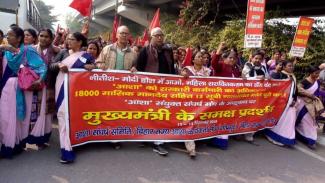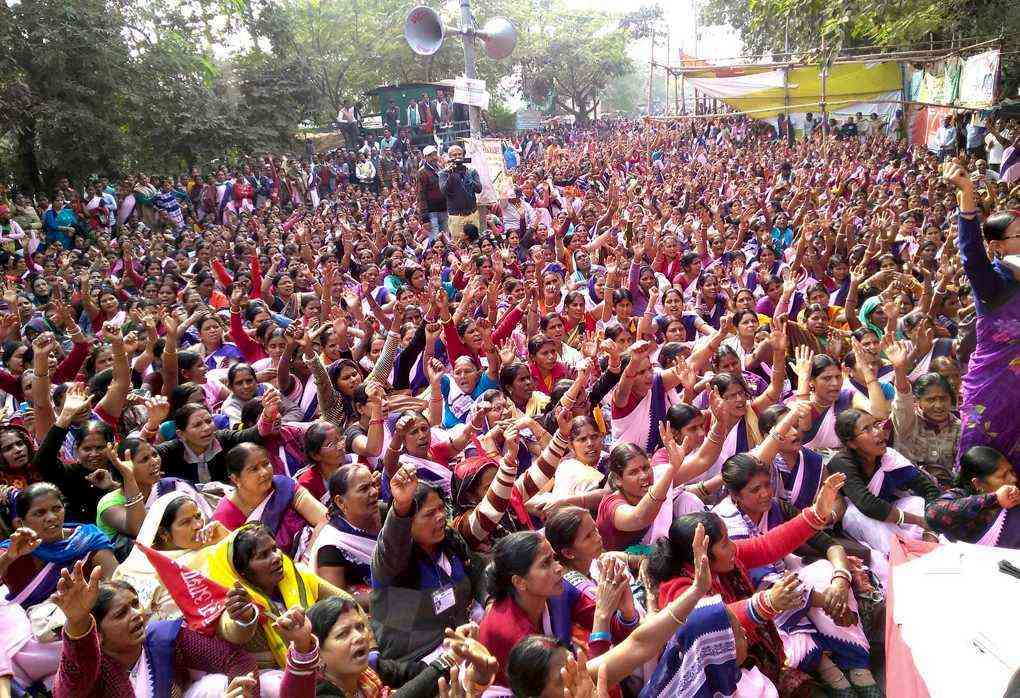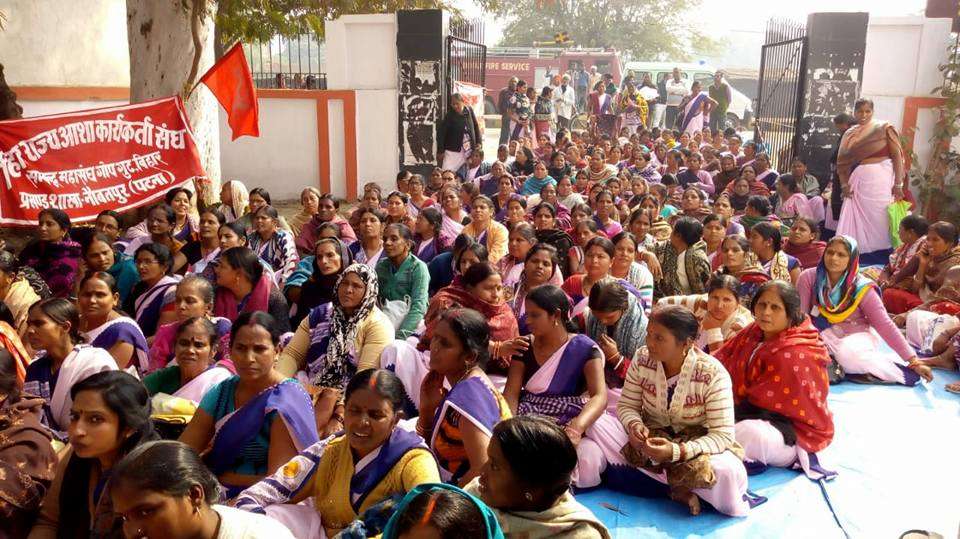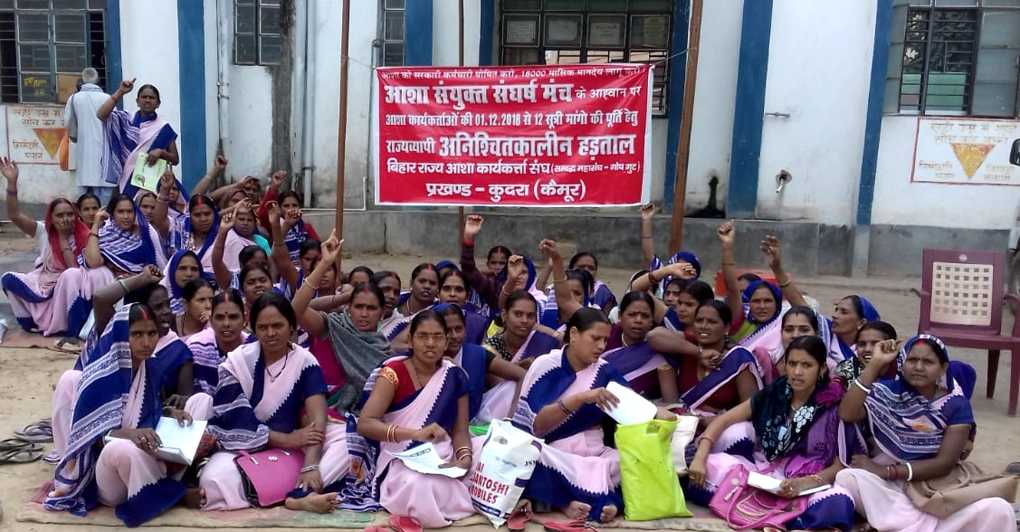
THE government ‘Accredited Social Health Activists’ (ASHA) workers in Bihar went on an indefinite strike from December 1 with a 12-point charter of demands. They constitute a formidable contingent of nearly one lakh workers spread over all 38 districts of nine administrative divisions in Bihar.
The strike call given by the Joint Struggle Forum (ASHA Sanyukta Sangharsh Manch) comprising of three major ASHA unions in the state met with an unprecedented success and on the very first day on 1 December ASHA workers came on the streets in huge numbers with their banners and slogans. They are demanding government employee status and a minimum wage (which the government terms ‘honorarium’) of Rs. 18000 besides many other demands that include 50% reservation for ASHAs in state nursing schools with appropriate age relaxation, appointments as ANM (Auxiliary Nurse Midwife) for qualified ASHAs and as BCM (Block Community Mobilisers) for ASHA facilitators, implementation of recommendations by the High-Level committee regarding work conditions and monthly remunerations, and social security benefits including ESI and Provident Fund.
With public health services almost completely absent at the grassroots, it is the ASHA workers who now constitute the backbone of India’s rural as well as urban health sector for the low income to the most poor and deprived sections. Yet they are overworked, underpaid and not even recognised as Government employees and skilled workers. Instead they are called ‘voluntary activists' who are paid a mere token ‘incentive’ instead of a salary, pension, and other benefits.

ASHAs: Key Link In Rural Healthcare
ASHAs are workers in the National Rural Health Mission, a flagship Government scheme. Jayati Ghosh, in her book Never Done and Poorly Paid: Women’s Work in Globalising India, noted that the NRHM and the ICDS (which employs the anganwadi workers) are “designed and launched by explicitly relying on the unpaid labour of women,” “trading on the time-worn stereotype of caring women who serve their families and communities selflessly without any thought of return.” The book had observed that exactly as women’s work in the home is famously ‘never done and unpaid,’ the work of ASHAs is ‘never done and poorly paid.’
The ASHA is a local woman who is meant to act as a link between her rural community and the Government health system. ASHAs are women who have completed eight years of school, and one ASHA serves one village or a population of 1000. Each ASHA gets a mere 23 days of training.
The NRHM Mission statement describes the ASHA as “a health activist in the community who will create awareness on health and its social determinants and mobilise the community towards local health planning and increased utilisation and accountability of health services. She would be a promoter of good health practices. She will also provide a minimum package of curative care as appropriate and feasible for that level and make timely referrals.”
On top of this, ASHAs are responsible for:
- Creating awareness on nutrition, sanitation, hygiene and toilet use, healthy living and working conditions, the existing health services and the need for timely utilisation of health and family services;
- Counselling women on birth preparedness, safe delivery, breastfeeding and complementary feeding, immunisation, contraception, preventing common infections and the care of young children;
- Facilitating access to government health services including immunisation, antenatal and postnatal check-ups, ICDS and sanitation;
- Escorting pregnant women as well as sick children to the nearest health facility for treatment or admission;
- Providing primary medical care for diarrhoea, fevers, first aid, as well as TB short course treatment
- Acting as depot holder for basic health provisions such as ORS, iron and folic acid tablets, chloroquine, disposable delivery kits, oral contraceptive pills, condoms, etc
- Informing health authorities about births, deaths, and any unusual health problems/diseases in the community
- Promoting toilet construction
- Working with gram panchayat to develop a comprehensive village health plan
Clearly, this is a huge amount of work, and most of it is skilled work, requiring not only basic medical knowledge, but an ability to explain health issues to local people, organise campaigns, and even have enough diagnostic skill to distinguish between ‘unusual’ health problems and ‘ordinary’ fevers and diarrhoea! The nature of the work, moreover, is such that there are no regular hours and the ASHAs are expected to be on call 24/7, since sicknesses and deliveries are usually unexpected. ASHAs are expected to arrange and pay for their own transport to the health centres and hospitals. A recent survey of ASHA workers in Delhi found that they may spend up to 12 hours on the job, including transport time; in rural areas, transport may take even longer.

So Much Crucial Work - And No Salary!
The work of ASHAs is disguised as ‘voluntary’ in order to justify the complete absence of any salary. The NRHM says that the ASHA is an “honorary volunteer and would not receive any salary or honorarium” and that her “work would be so tailored that it does not interfere with her normal livelihood”! So the Government, while using the ASHAs as virtually the only available village-level healthcare in rural areas, is claiming this work is just voluntary service and denying it is a livelihood that deserves to be paid!
ASHAs get small ‘incentive’ payments for every task they can prove they have done, and some state governments have also fixed small monthly payment amounts. But the pay never amounts even to a minimum wage for unskilled work - let alone the pay and benefits to which a government employee is entitled.
To get a sense of just how important the work of the ASHAs is, we can cast our eye on the crisis of healthcare for women and children in India.
In 2015, India had 40% of undernourished children of the world. India has some of the worst rates of stunting and maternal and infant mortality in the world.
The National Health Profile 2018, an annual report released recently by the Central Bureau of Health Intelligence (CBHI), found that the Government of India spends just 1.3 per cent of the GDP for public healthcare, way less than the global average of 6 per cent. The per capita public expenditure by the government on health stands at Rs 1,112 - which amounts to a pitiful Rs 3 per day! India spends less on healthcare than Nepal, Maldives, Sri Lanka and Bhutan.
According to the report, one allopathic government doctor in India, on an average, attends to a population of 11,082, which is 10 times more than the WHO recommended a doctor-population ratio of 1:1,000.
The situation is worst in Bihar where one doctor serves a population of 28,391 people. Uttar Pradesh is ranked second with 19,962 patients per doctor, which is followed by Jharkhand (18,518), Madhya Pradesh (16,996), Chhattisgarh (15,916) and Karnataka (13,556).
However the report found that in spite of this abysmally low priority given by the Government of India to healthcare, there has been “noteworthy progress in health indicators such as the infant mortality rate and maternal mortality rate (MMR) in the country.” There was a 11-point decrease in MMR between 2010-12 and 2011-13, leaving the national MMR at 167 per 1,000,000 births.
Union Health Minister JP Nadda had the incredible gall to cite the NHP report to claim the decrease in MMR as an ‘achievement’ for the Government while remaining silent on the shamefully low spending by the Government on health.
The question is - if the Government is spending so little, and there is so little medical care available in rural areas, how has the decrease in infant and maternal mortality rates been achieved? Clearly, it is the ASHAs (along with the Auxiliary Nurse Midwives- ANMs, and Anganwadi workers)- the only ones providing any direct pre- and post-natal care to women and new-borns, facilitating institutional deliveries, treating diarrhoea which is the number one killer of infants in India, and advising on nutrition and breastfeeding, who deserve the credit for this achievement.
And yet these women workers are not recognised by the Governments at Centre and State as Government employees!

The Bihar ASHA Strike
The strike was complete and work remain suspended in primary health centres (PHCs), the emergency health services continued as they were exempted from the strike. The government’s vaccination program which was schedule to begin from 5 December could not take off due to strike.
Shashi Yadav, president of Bihar ASHA Workers’ Union (AICCTU) said in a press conference that ASHAs in Bihar are struggling for a very long time, as in other states, for fixed monthly salary and dignity.
Bihar has the second highest (93,687) contingent of around one million total ASHA workers in India. They are the key link (practically, the only link) between healthcare system and rural population and have to perform many essential tasks. Yet the government considers them ‘volunteers’ only not to pay them due wages, irrespective of the fact that they put in lot of hard labour. She said that the Nitish government has not implemented even the agreement made on 29 June, 2015 regarding the increase in so called ‘honorarium’ even after so many years.
They as community health workers are an essential component of central government’s National Rural Health Mission (NRHM). They work in close coordination with gram panchayat, SHGs, ANMs, Anganwadi workers etc to cater to a certain population at village level without any employee/worker status or regular wages. Instead they are paid ‘incentives’ for different tasks at fixed rates which practically is highly underpaid piece-rate payment in accordance with neoliberal payment structures and amounting to modern day slavery. Some their working hours extend beyond 12 hours a day when some medical emergency is encountered. They have to spend lot of time in travelling during work, making home visits, going to health facilities and within and outside of the villages. Moreover, they have to work under conditions where grievance redressal mechanism are either completely absent or very weak, while accountability on their part is very very high.
Bihar has its own additional woes inflicted through extra workload as each ASHA worker has to cater to a population of 1075 against a national average of one ASHA per 900 population, in spite of Bihar being one of the High Focus states.
On 1 December ASHAs assembled in front of all primary health centres all over Bihar to press for their genuine demands. The PHC gherao continued in the following days with increased strength and determination. The support and sympathy to their movement by wider sections of general public became a testimony to the genuineness of their demands. Left parties and major trade union centres issued statements in solidarity.
Solidarity Meetings by Left parties, TU centers and AIARLA in Support of ASHA Strike
All India Agricultural and Rural Workers Association (AIARLA) organized mass protest in their support in all blocks on Dec 5. AIARLA National General Secretary Com. Dhirendra Jha, Bihar State President and Darauli (Siwan) MLA Com. Satyadev Ram, and State Secretary Com. Gopal Ravidas issued a joint statement on 3 December 2018 supporting the ongoing ASHA workers’ strike in Bihar and demanded that the State government hold talks with the ASHA workers and pay them monthly honorarium without delay.
Com. Dhirendra Jha said that AIARLA will organise Block level solidarity meetings on 5 December in support of ASHA workers. Effigies of the Prime Minister and Chief Minister will be burnt at the meetings. ASHA workers are working under the National Health Mission and it is they who are the means of bringing the State’s health services to the people. The Chief Minister had earlier assured them that they would be paid monthly honorarium but today he remains silent on the issue.
CPI(ML) organized solidarity protests in many districts on 7-8 Dec. CPI(ML), CPI, CPM, SUCI, AIFB and RSP issued a joint statement asking CM Nitish Kumar’s immediate intervention to accept ASHA’s demand.
CPI(ML) MLA Mahboob Alam joined ASHA workers in their dharna at Balrampur on 6 Dec. AICCTU Bihar General Secretary RN Thakur demanded fulfillment of their demands and called for solidarity protests by all AICCTU affiliated unions in Bihar. He also demanded regularization of all Aanganwadi and Mid-day meal workers.

The Strike Continues
Hundreds of ASHAs continued to pour in daily to gherao the PHCs leading to a complete halt of health services in Bihar. In Motihari and many other places striking ASHAs held sit-in and stayed at protest site day and night. Many volunteers came forward in arranging for them food etc. In Siwan, they held a massive sit-in protest on 5 Dec in the grounds of the district hospital.
Striking ASHAs blockaded district level hospitals and Civil Surgeon offices which was attended in massive numbers. CS offices remained locked from outside a whole day on Dec 10. The next day there were big demonstrations in front of District Magistrate offices in all districts. A proper notice was served to Bihar administration 15 days in advance but the latter did not bother to even call ASHA organisations for talks. Bihar ASHA Workers’ Union President Shashi Yadav, ASHA Sangharsh Samiti President Mira Singh, Vishwanath Singh and Kaushalendra Verma have warned Bihar government to refrain from using any overt or covert repressive tactics in face of many reports of police and administrative highhandedness towards peaceful ASHA protesters at local levels.
At a time when a major part of health services in Bihar have come to a virtual halt, the state Health Minister Mangal Pandey who is a minister from the BJP quota preferred to go on an official foreign trip instead of making any effort to resolve the striking ASHAs’ problems. Amidst this apathy, the ASHAs’ determination could not be dampened and they gathered in the state capital Patna from all parts of the state to raise their voice loud and clear. They went on to protest in front of the CM office on 13th in thousands, stayed there in night and continued protest till 14th evening. They held a massive march through main roads which was converted into a two day huge sit-in protest where the 12-point charter of demands was again reiterated.
The meeting was presided by Shashi Yadav, Mira Sinha, Kusumi Devi while Rambali Prasad, Vishwanath Singh and Kaushlendra Verma conducted the proceedings. Comrade Shashi Yadav demanded dismissal of the Health Minister who had gone on foreign trip and reminded Nitish Kumar first implement his own agreement done in June 2015 with ASHA workers unions of Bihar.
Mahboob Alam, MLA and leader of CPI(ML) legislative group in Bihar addressed the ASHA workers on 13th and expressed his solidarity. He said it is a sad state of affairs in Bihar that demands of ASHAs which even the Chief Minister himself accept in principle as genuine and signed a written agreement are not yet fulfilled. This reflects the hypocrisy of the state ruling establishment led by JD(U) and BJP which is clearly evident in the Health Minister’s irresponsible act of going to a foreign trip. He is neither concerned with the demands of ASHA workers nor he is sensitive to the difficulties faced by the people due to suspension of health services. Comrade Mahboob demanded from the Chief Minister to immediately call ASHA Sangharsh Manch leaders on negotiation table and fulfil his own promises.
The sit-in was also addressed by many leaders from different organisations who came in solidarity including employees leader Manjul Kumar Das, Ganesh Shankar Singh of CITU, Ranvijay Kumar, AICCTU Bihar Secretary, Mid-day Meal Workers’ Union president Saroj Chaube, Aanganwadi workers leader Usha Sahani, Employees’ Federation (Gope) leader KD Vidyarthi, Mamta Sangharsh Samiti leader Md. Lukman, and Courier workers’ leader Vashishtha Prasad Singh. They said that it was the hard work of ASHA workers that Bihar government received an award for improvement of health services in the state but Nitish is not able to meet the minimum requirements of this very backbone of the health services. This also exposes another fallacy behind the so called ‘sushasan’ (good governance) of his regime. Many leader AIPWA president Meena Tiwary joined this protest the next day on 14th to express their support.
ASHA in Hindi means Hope. The immense success and resolve of this strike in Bihar may prove to be a flag-bearer of the ASHA workers’ struggle going on in every state in the country on exactly same set of demands. This strike is a bright ray of hope for the ASHAs who are forced to work in hopeless work conditions without pay and without employee status. This strike exposes the hypocrisy of the establishment as well as new tools of extreme exploitation of working classes which were evolved gradually by the neoliberal policy regime to extract labour and amass profit ultimately for the private players and cronies in the health sector. Now there is a need for a countrywide united initiative of struggling ASHA workers on a single platform. Bihar ASHAs have shown us the way.
(A version of this report appeared as an article by Kavita Krishna in scroll.in)
Liberation Archive
- 2001-2010
-
2011-2020
- 2011
- 2012
- 2013
- 2014
- 2015
- 2016
- 2017
- 2018
-
2019
-
JANUARY-2019
- Oust the Fascist Modi Regime! Rescue India, Rebuild India!
- Assembly Elections 2018: A Blow To Fascist Politics
- The Elitist Reaction to the Zomato Delivery Man
- More Orders, More Money
- Why I Stole food
- Kisan Mukti March : When United Peasant Resistance Defused The Fascist Aggression
- Kisan Mukti March : The Farmers' Freedom March
- Kisan Mukti March : Civil Society and Opposition Parties Come out in Support
- MANIFESTO OF INDIAN FARMERS
- Farmers' Unity will become the Biggest Force in Fighting Fascism
- Save Our Farmers
- The Fraud of Farm Suicide Numbers
- Agrarian Crisis = Nation's Crisis
- Sinking in a Sea of Debt
- Why The Market Has Not Worked For Farmers
- Agrarian Crisis: A Crisis of Women Farmers
- Overworked, Underpaid, Unrecognised: Bihar ASHAs on Indefinite Strike
- Seminar: 'Women's Rights and Increasing Attacks on Democracy'
- Supreme Court as Custodian of the Constitution
- Comrade Vinod Mishra's Bhojpur
- Why Supreme Court Order Doesn't Amount to 'Clean Chit' to Modi Government on Rafale
- All Over The World, Home Is The Most Unsafe For Women
- FEBRUARY-2019
- MARCH-2019
- APRIL-2019
- May-2019
- LIBERATION, JUNE 2019
- Liberation JULY 2019
- LIBERATION, August 2019
- Liberation, SEPTEMBER 2019
- Liberation, OCTOBER 2019
- Liberation, NOVEMBER 2019
- Liberation, DECEMBER 2019
-
JANUARY-2019
- 2020
- 2021-2030
Charu Bhawan, U-90, Shakarpur, Delhi 110092
Phone: +91-11-42785864 | Fax:+91-11-42785864 | +91 9717274961
E-mail: info@cpiml.org







